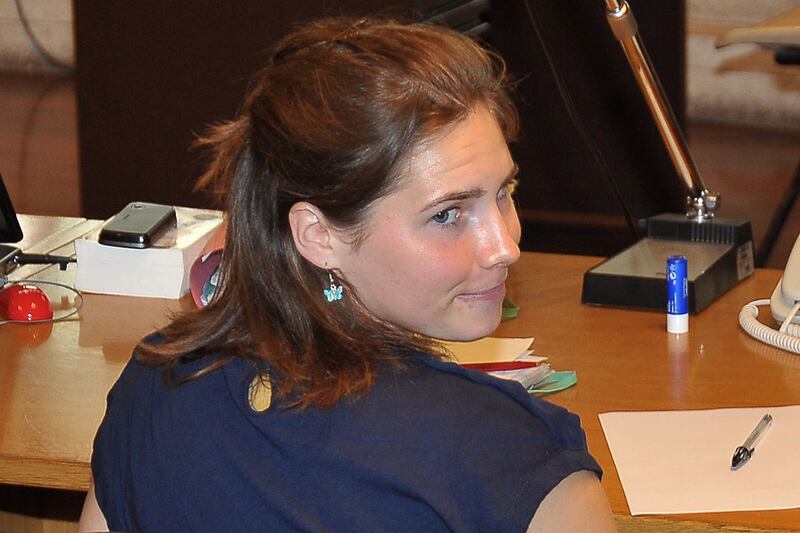Another sign of hope for Amanda Knox?
The appellate court hearing of Knox's murder appeal in Perugia, Italy was shown damning video on Monday outlining over 50 breaches in their evidence collection. Independent forensic experts examining two key pieces of evidence showed how the forensic team wore dirty gloves and used substandard methods when they collected evidence in the case. On Friday, the court will hear from the prosecution, which is expected to refute the findings. Lawyers for Rudy Guede are also considering petitioning the court to reopen his case, since the same forensic team’s also collected evidence that led to his conviction.
Knox is serving 26 years for the murder of her British roommate Meredith Kercher.
ADVERTISEMENT

On July 9, Knox turned 24; it was her fourth birthday behind prison walls. She celebrated over a cappuccino with her Perugian lawyer Luciano Ghirga. On the eve of her birthday, supporters back home in Seattle raised more than $15,000 for her defense at a birthday fundraiser with live music and a silent auction that included a golf weekend donated by Donald Trump. She wrote a letter to the attendees: “Dear Friends, I want so badly to be there to rock out with you. It's so cool and I'm truly honored that you're sharing with me and my loved ones my birthday (and celebrating all those motives like love and truth). Thank you for your support of me and my family. I'm with you in spirit. Spirit hugs. Cheers. Your friend, Amanda.
This could easily be Knox’s last birthday behind bars—a notion nearly unimaginable just a few months ago. Yet now there is a very good chance that she will be released this fall. The Italian legal system allows all convicts an automatic appeal, and Knox’s is proving to be a game changer.

The stir surrounding the murder of Kercher—or, rather, the conviction of Amanda “Foxy Knoxy” Knox—has defied all logic, taking on a life of its own. For the last four years, her “live from Italy” trials have been a network-news staple and a hit-generating windfall for both tabloid and mainstream press websites. The case has been a moneymaker for journalists who might have found work scarce if not for Knox. It has been a career maker for many more—anonymous bloggers are now book authors, and lawyers affiliated with the case have become some of the most sought-after in the country. Rudy Guede’s lawyer Valter Biscotti, whose client was also convicted of helping to kill Kercher, has been involved in three of Italy’s highest-profile murder cases since working on this one.
An acquittal will create a vacuum for those who have benefited from the cottage industry spawned by the case. But almost certainly, a new one will develop in Seattle, with Knox sure to be a darling of the talk-show circuit, and possibly even an advocate for other prisoners. There is already a nasty media war for her first post-prison interview—or her first in-prison interview if she isn't sprung. The price? Reportedly, upwards of $1 million in cash and perks.
Knox may well be completely oblivious to all that is happening around her. She is doing what she can just to survive each moment, say her lawyers, and is trying to strike a balance between getting her hopes up and preparing for the worst. She is an active inmate, participating in the prison choir, studying foreign languages, and practicing classical guitar, according to the warden. But even the casual observer can see how much she’s changed over the last four years. She has gone from Foxy Knoxy, queen of the tabloids, to a very demure woman, much thinner and older-looking; the stress from what she maintains is a wrongful conviction has taken an obvious toll. Sources close to her family say she is cautiously optimistic that she will be released by Christmas, and is envisioning picking up where her life left off, far from Perugia. She wants to be married, they say, and have children.
But first she has to get out of jail. Knox and her former Italian boyfriend Raffaele Sollecito were convicted in December 2009 of murder, sexual assault, staging a crime scene, and carrying a murder weapon relating to the murder of Meredith Kercher, who died on November 1, 2007. Knox was also convicted of falsely accusing another man of the murder during an intense interrogation, for which she is serving one year more than Sollecito. The conduct of both the Italian prosecutor and crime-scene investigators has been vehemently criticized in the United States, where her supporters say Knox and Sollecito are the victims of a wrongful conviction. Sloppy police work and substandard forensic testing have been the focus of her appeal, and Judge Claudio Pratillo Hellman has been amicable to most of the defense's requests, keenly aware that his every move is being scrutinized by a global audience. He makes it a point to sit at the bench with no preconceived notions, even telling the court, “The only thing we know for sure is that Meredith Kercher is dead.”
The most significant coup in the appeal so far for Knox and Sollecito has been a 145-page report outlining an independent review of key forensic evidence. To their credit, the defense teams for Knox and Sollecito requested the review during the appellate phase, even though the same request had been denied in the original trial. Back then, the judge said it wasn’t necessary. Now it's proving to be pivotal.
The report, obtained by Newsweek, was submitted into evidence on June 29 by Stefano Conti and Carla Vecchiotti, two independent experts from Rome’s La Sapienza University forensic department. They were given 60 days by the appellate judge to examine two crucial pieces of evidence: the clasp from the bra that someone cut from Kercher’s body after her death, with Sollecito’s DNA on the tiny metal hook, and a kitchen knife found in Sollecito’s apartment that has Knox’s DNA on the handle and what the prosecution contends is Kercher’s DNA in a groove on the blade. The experts didn’t exactly turn up any surprises to those obsessed with this case, but when they argue their findings in court the last week of July, the jury will hear for the first time just how badly the Italian forensic team in Rome, led by Patrizia Stefanoni, mishandled the forensics of this case.
The experts determined that both items were potentially altered by contamination because Stefanoni’s team did not follow proper procedure, either in the lab or at the crime scene—a point that defense teams for Knox and Sollecito unsuccessfully raised in the original trial. The bra clasp was highly contentious because it was collected 46 days after Kercher’s corpse was found. The crime scene was sealed, but the forensic team’s own video footage shows that the clasp—repeatedly identified and numbered, though systematically left uncollected—mysteriously moved across the room during a six-week period.
Conti and Vecchiotti also write that the knife found in Sollecito’s apartment should never have been admitted as evidence because the specimen on the blade was too small to double-test, and initial test results were achieved through methods too substandard to be considered accurate. The prosecution maintains that’s because the knife had been cleaned with bleach. The defense maintains it’s because Kercher’s DNA was never there in the first place. "We believe that the technical tests are not reliable,” say the experts. “It cannot be ruled out that the result obtained may stem from contamination.”
With the knife and the bra clasp—effectively the smoking guns in this case—discounted by the independent experts, one wonders just what is left that ties Knox and her erstwhile Italian lover to the murder. Without the knife and the bra clasp, all the remaining evidence linking Knox to the crime is circumstantial. The appellate court has heard testimony from controversial witnesses on both sides—from a heroin-addicted homeless man who testified for the prosecution to a convicted baby killer and a Neapolitan Mafia turncoat who testified for the defense.
In the United States, the complexity of the case might raise it to the threshold of reasonable doubt, as was demonstrated when Casey Anthony was acquitted of murdering her daughter earlier this month. In Italy, however, circumstantial evidence often counts for as much as forensic evidence in the court of law. “It is not uncommon in Italy to give equal weight to circumstantial evidence, especially in cases where the defendants have been caught making false statements,” says Italian criminal-defense attorney Alessandra Batassa, who has tried many murder cases. “This is a classic case where it was relied on to the extreme.”
What complicates the Kercher murder case more than anything else, if that’s possible, is the third person convicted of the murder, Ivory Coast native Rudy Guede. To be sure, Guede is hardly a reliable witness—traces of his fingerprints, DNA, feces, and semen were found at the crime scene in ample quantity—but he is the only person to admit being with Kercher the night she was killed. The problem for Knox and Sollecito is that he also says they were there.
Now the appellate judges and jury will have to sift through reams of documents, weigh bizarre witness testimony, and decide the value of the independent experts’ report to determine whether Knox and Sollecito should go home or stay in jail. Closing arguments begin September 5, and a verdict is expected by September 24. The only sure thing is that whatever they decide, it will be highly controversial.






